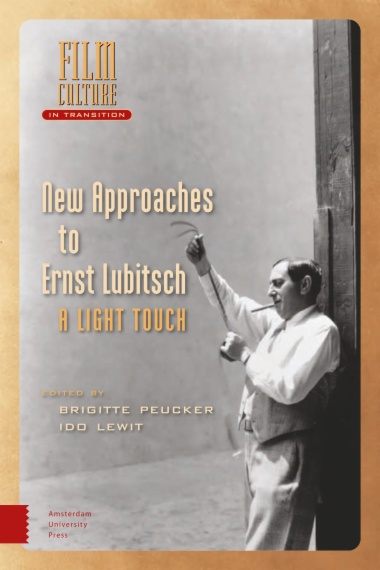This exciting collection of unpublished essays on Ernst Lubitsch addresses multiple gaps in scholarly and critical engagement with the director. His understudied early German films shed light on Jewish culture, on the relation of comedy to gender and the influence of theatre on his filmmaking. The popular historical epics brought Lubitsch an invitation to Hollywood in 1922. There, Lubitsch helped develop the film musical and notably contributed to the genre of Hollywood romantic comedy. The well-known scholars—film historians, archivists, and theorists—whose essays appear in this volume expand our knowledge of the set designers, actors, directors and members of the emigré community who contributed to Lubitsch’s vibrant films. An emphasis on the role of material objects opens up a new dimension of critical engagement with the director. Light is shed on neglected films, and the antifascist dimension of his oeuvre brings his political stance clearly to light. As these essays make clear, Lubtisch’s cinema is elusive and deserving of our close attention.
- Cover
- Table of Contents
- Acknowledgements
- Part I.: Identity and History
- 1. Jewishness in Lubitsch’s Milieu Films: The Pride of the Firm and Shoe Palace Pinkus
- 2. The Mirror and the Mother-In-Law: Bourgeois Jewish Femininity in The Pride of the Firm, The Blouse King, and When I Was Dead
- 3. Lubitsch Revisits the Schmatta Trade: The Shop Around the Corner
- 4. To Be or Not to Be: Revising History in Light of Migrant Interactions
- Part II.: Theatricality and Performance
- 5. “Done!”: Kurt Richter’s Perspectival Set Design in Lubitsch’s German Films
- 6. Lubitsch’s May McAvoy Trilogy: Threesomes, Triangles, Allegories
- 7. Theatrical Yet Deeply Cinematic: Situating Lubitsch’s Musicals Within the Early Sound Era
- 8. Miriam Hopkins Learns to Wink
- Part III.: Objects and Spaces
- 9. Regulating the Gaze and the Voice for a Cinema in Transition: The Merry Jail and So This Is Paris
- 10. Lubitsch, In and Out of Bed
- 11. Ninotchka: Pleasure and Politics Objectified
- Susan Felleman and Catherine Walworth
- Part IV.: Elusive Style
- 12. That Uncertain Feeling and the Symptoms of Married Life
- 13. Ernst Lubitsch, Censored and Censoring
- 14. Chaplin / Lubitsch / Chaplin: Influence and Counter-Influence in A Woman of Paris, The Marriage Circle, and A Countess from Hong Kong
- 15. Films in Which Nothing Very Much Happens: Unstable Knowledge in Lubitsch’s Late Silent Work
- Bibliography
- Index
- List of Illustrations
- Figure 1. Then and now: Ernst Lubitsch as Siegfried Lachmann in The Pride of the Firm (1914). Courtesy of the Murnau-Stiftung, Wiesbaden.
- Figure 2. Ernst Lubitsch as Sally Pinkus in Shoe Palace Pinkus (1916). Courtesy of Stiftung Deutsche Kinemathek, Berlin.
- Figure 3. The Shop Around the Corner frame enlargement—Sara Haden, Joseph Schildkraut, Felix Bressart, James Stewart. MGM, Loew’s Inc. (distributor), 1940.
- Figure 4. The Shop Around the Corner frame enlargement—James Stewart, William Tracy, Margaret Sullavan. MGM, Loew’s Inc. (distributor), 1940.
- Figure 5. Constructing a miniature set—Lubitsch as Puppeteer in The Doll. Die Puppe, PAGU, UFA (distributor), 1919.
- Figure 6. Kurt Richter’s Perspectival Set Design—The Infinite Image Archive, Lubitsch’s The Oyster Princess. Die Austernprincessin, PAGU, UFA (distributor), 1919.
- Figure 7. Ernst Lubitsch on set for the “Charity Ball” scene of Three Women. Warner Brothers, 1924.
- Figure 8. “Lobby Card” for Three Women (1924). Lamont (Lew Cody) has won over heiress Jeanne Wilton (May McAvoy). From the author’s collection.
- Figure 9. Lubitsch’s stage-like arrangement of characters and camera during “Dream Lover” in The Love Parade. Paramount Famous Lasky Corp., 1929.
- Figure 10. Lubitsch moves beyond a stage-oriented concept of musical numbers by having peasants working in the fields outside Helene’s moving train sing the chorus of “Beyond the Blue Horizon” in Monte Carlo. Paramount Pictures, 1930.
- Figure 11. Lilyan Tashman (left), Lubitsch (holding a microphone), and Monte Blue (second from right) in a publicity still for So This Is Paris. Warner Brothers, 1926.
- Figures 12 and 13. Ina Claire as Grand Duchess Swana (left) and the wife of the Minister of the Imperial Court (right) in the costume of a seventeenth-century noblewoman at the 1903 Romanov Anniversary Ball. Ninotchka, MGM, 1939 (left) and Romanov Anniver
- Figure 14. The Dream of a Caryatid? Ninotchka (Greta Garbo) and Leon (Melvyn Douglas) in his apartment. Ninotchka, MGM, 1939.
- Figure 15. The two male characters mirroring each other in Angel. Paramount, 1937.
- Figure 16. Frederick, Tony, and Maria form a perfect triangle in Angel. Paramount, 1937.

